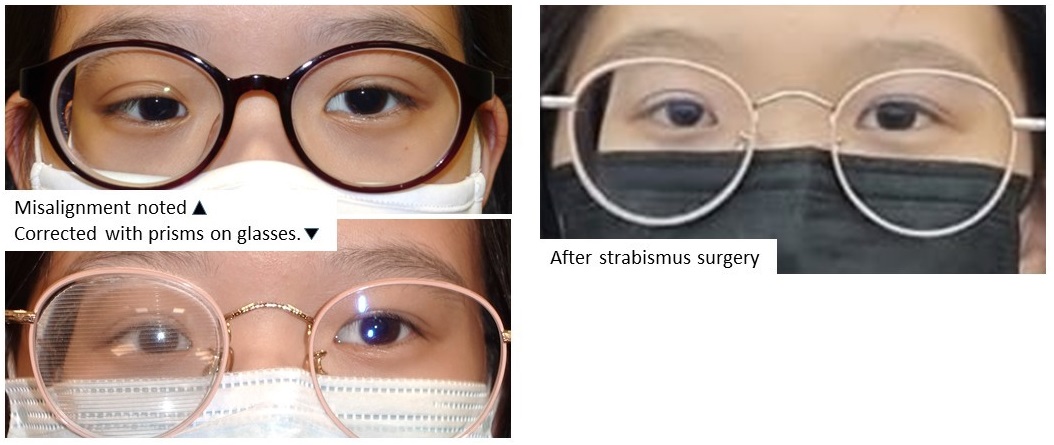Strabismus or a squint is an abnormal alignment of the eye. It can occur both in childhood and later in adulthood. The impact of strabismus on the quality of life has been documented, particularly during adulthood. However, the psychological and social impact of this condition on children is often under-estimated. These children can be discriminated against, not just by their peers but also by adults, with one study even showing that children with strabismus may be less likely to be invited to birthday parties1! This has an effect on children’s psyche, and studies have shown that children with strabismus can be more vulnerable to anxiety, depression, and alcoholism later in life2. Parents of these children can also be negatively impacted.


Child with exotropia
Understanding how strabismus impacts a child’s quality of life (QOL) should be an important key to guide treatment. In a study done in Singapore, QOL was assessed in 60 children with strabismus and 60 aged-match controls aged 5-16 years using 2 questionnaires - the Intermittent Exotropia Questionnaire (IXTQ) and Adult Strabismus 20 Questionnaire (AS-20)3.
Children answered their own questionnaires (the younger ones with the help of study team member), while parents also filled in question according to how they perceived their children were affected by strabismus.
We found that strabismus has a significant effect on the quality of life of Singaporean children, even in those as young as 5 years of age! Children were most bothered by having to wait for their eyes to clear, being worried about their eyes, bothered about people wondering what may be wrong with their eyes and worried about what people thought of them.
Parents were more worried about their children’s eyes and eyesight, their children being teased, what others thought about their children and their children’s ability to make friends. In particular, parents were more likely to underestimate certain psychosocial aspects of strabismus, such as how the children felt different or how concerned they were about people avoiding them.
Understanding how strabismus impacts children and their families is important in guiding treatment, not only from an ophthalmological point of view but also in providing holistic care for these children, which is fundamental in their development. At this point, not much is known about the use of psychosocial interventions to improve the quality of life in patients with strabismus, however, with further research, we can hopefully bridge that gap and provide the additional emotional and social support required.
-
Mojon- Azzi SM, Kunz A, Mojon DS. Strabismus and discrimination in children: are children with strabismus invited to fewer birthday parties?
Br J Ophthalmol. 2011;95(4):473-476
-
Lin S, Congdon N, Yam JCS et al. Alcohol use and positive screening results for depression and anxiety are highly prevalent among Chinese children with strabismus.
Am J Ophthlamol. 2014;157(4):894-900
-
Sim B, Yap GH, Chia A. Functional and psychosocial impact of strabismus on Singaporean children. J AAPOS. 2014 Apri;18(2):178-82
Contributed by:

Dr Tay Su Ann
Consultant
Department of Paediatric Ophthalmology and Strabismus
Singapore National Eye Centre
Visiting Consultant, KK Women’s and Children’s Hospital
-----------------------------------------------------------------------------------------------------------------------------
The 3 most common reasons why squint (eye misalignment) surgery is needed is to 1. Realign eye; 2. Relief any double vision; or 3. Eliminate an abnormal head posture (needed to maintain alignment). However, the psychological impact of a squint or strabismus is often under appreciated.
Andrea, aged 13, underwent squint surgery last year. She shares her journey with us.
Hi Andrea, we know you had a squint for a long time. Could you tell us how it affected you?

It has affected me in 2 areas. First is that people saw that my eyes are not too straight. Second was that I saw double vision because of the squint. As a result of the double vision, it affected my daily activities, so I had to put a piece of plastic with lines (“prism”) on the right side of my glasses to make me see 1 image. That made me look very ugly and affected my social interaction with my classmates/friends because they found me weird.
Did your friends notice your squint and ask you about it?
In the beginning, not all my friends noticed my squint but they saw my prism which made me look weird. When they asked me about it, I just explained to them saying that I have double vision so I had to paste the prism on my glasses.
I know you had an operation. Was it scary? How do you feel now it is over?
No, I didn’t feel scared about the operation because I knew that it was to correct my double vision. The operation was not scary at all because the doctors and nurses had come to explain to me how the operation would be done and kept telling me that they would look after me during the operation.
I had 2 surgeries to eventually correct my double vision problem. After the second surgery, I no longer see double vision and my eyes look straighter now. I also need not put prism on my glasses anymore. All my friends praise that now I look very pretty with my glasses without the prism!
-----------------------------------------------------------------------------------------------------------------------------
We also asked Andrea’s mother how her journey was.
When did you notice there was something not right with Andrea’s eyes?
I first noticed Andrea’s eye balls did not look aligned when she was 2-3 years old but during that time, doctor and friends mostly said it is likely due to the face and nose bridge not fully developed yet and asked me to wait and see. When Andrea was 4 years old, her eyes check-up showed that she has “Lazy eye” & bad disparity in the degrees between her 2 eyes. We tried “Patching” to improve her “Lazy eye” and put eye-drop to slow down her increasing degree. To add on the problem, she started having double-vision when she was 9 years old which affected her school and daily activities.
Through the years, how did you and the family cope?
Throughout the 10 years, we had to go for frequent eye checks. The worse period was when she had to have a plastic patch known as “prism” on her glasses as we would always receive odd looks from people as if she was a “special needs child” and when we took photos, I had to ask her to remove her glasses so that she doesn’t look weird in her photos.
How do you think Andrea coped?
I am actually thankful that Andrea took all her treatment rather positively. She accepted patching her eye when she was young and then prism on her glasses even though it made her look weird at an age when girls wanted to look pretty.
What advice would you have for parents who have just found out their child has strabismus?
After 2 rounds of eye surgery within a 6-months gap, Andrea’s eyes are better aligned and her double-vision problem is cured! She no longer needs prism on her glasses and is now a happy confident pretty teenager.
With our experience, I would like to urge parents who have found out that their child has strabismus to bring your child for check-up as soon as you can because early intervention will allow the doctor to diagnose, evaluate and suggest remedy to help improve the condition. In the event that your doctor suggests surgery, do not be overly worried. The surgery is safe and can rectify the condition.
Back to
EyeSight main page.
